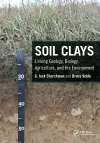
Soil Clays
2 authors - Paperback
£43.19 was £47.99
G. Jock Churchman is adjunct senior lecturer at the University of Adelaide (Australia) and adjunct
associate professor at the University of South Australia. Jock Churchman’s clay interests began with
a PhD in chemistry on halloysite at the University of Otago in his native New Zealand, followed
by industrial ceramic research (1970–1971). He held a postdoctoral fellowship in soil science at the
University of Wisconsin–Madison (1971–1973) and was employed at the New Zealand Soil Bureau
(1973–89), then at CSIRO (1989–2003), the University of Adelaide (2003–2012) and the University
of South Australia (2013–2014). He has also held visiting fellowships in soil science for one year at
Reading University (UK) and for six months at the University of Western Australia. His research
has encompassed halloysite; acid dissolution of montmorillonite; dust transport; clay mineral genesis;
clay–organic complexes; the influence of clay mineralogy on soil physical properties; clays in
sodic soils; the characteriation of bentonites and their industrial and environmental applications;
and the philosophy of soil science.
He has published nearly 150 refereed papers and coedited four books, most recently The Soil
Underfoot: Infinite Possibilities for a Finite Resource (CRC Press, 2014) and Natural Mineral
Nanotubes (CRC Press, 2015). He is a former editor (now emeritus) of Applied Clay Science. He
has received awards from the New Zealand Society of Soil Science, Soil Science Australia, the
Association Internationale pour l’Étude des Argiles (AIPEA) and the Clay Minerals Society.
Bruce Velde is an emeritus researcher for the Centre Nationale de Recherche Scientifique at the
Ecole Normale Supérieure in Paris. He did his PhD at Montana State University (1962) under the
direction of John Hower, then he did a postdoctoral study at the Carnegie Geophysical Laboratory
in Washington DC (1962–1965) after which he joined the CNRS in Paris.
The initial research subjects treated were the evolution of clay minerals in sediments and sedimentary
rocks, and their stability under different laboratory conditions of pressure and temperature.
During the latter period, he published 237 refereed papers, authored and coauthored 8 books on
clays and their chemical relations in natural situations and advised 22 PhD theses on these subjects.
His books are Clays and Clay Minerals in Natural and Synthetic Systems (Springer, 1977);
Introduction to Clay Minerals: Chemistry, Uses and Environmental Significance (Chapman & Hall,
1992); Archaeological Ceramic Materials: Origin and Utilization (Springer, 1999); Clay Minerals:
A Physico-Chemical Explanation of Their Occurrence (Elsevier, 2000); Illite: Origins, Evolution
and Metamorphism (Springer, 2004); The Origin of Clay Minerals in Soils and Weathered Rocks
(Springer, 2008); Soils, Plants and Clay Minerals: Mineral and Biologic Interactions (Springer,
2009); Origin and Mineralogy of Clays: Clays and the Environment (edited) (Springer, 2013); and
Geochemistry at the Earth’s Surface (2016).
The evolution of his work was to understand the chemical and physical reasons for the variety
and stability of clay mineral associations from depth towards the surface of the Earth. He also did
work on the formation of clay-associated structures (